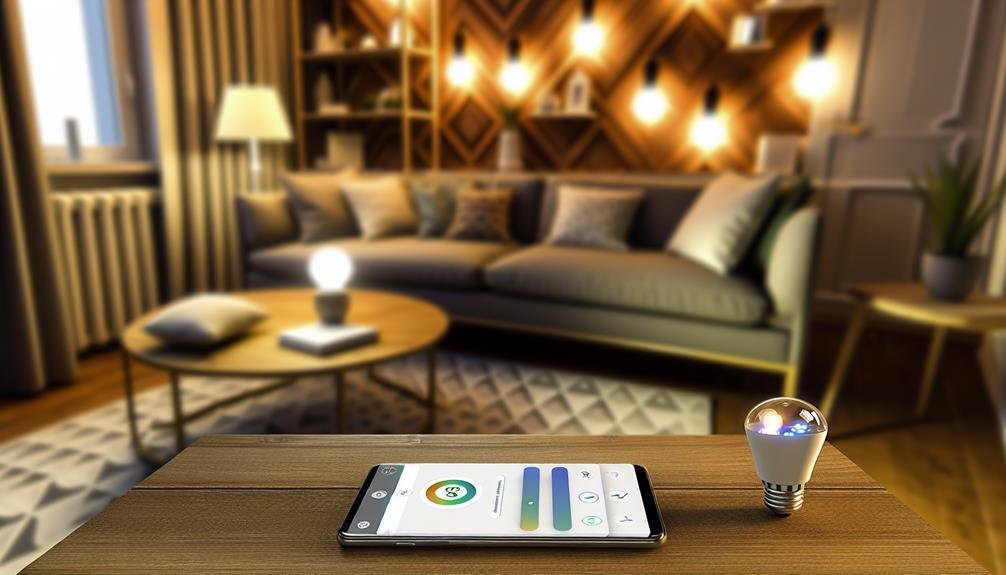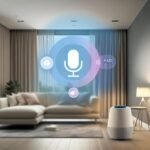You may be thinking that automating your home lighting with smart home automation is complicated and time-consuming, but it doesn't have to be. With the right smart lighting system, you can easily control and customize your home lighting with just a few taps on your smartphone or a simple voice command.
Imagine walking into a perfectly lit room without even lifting a finger. In this discussion, we will explore the steps you can take to automate your home lighting, from choosing the right smart lighting system to integrating it with other smart home devices.
So, get ready to transform your home into a seamlessly connected and effortlessly illuminated haven.
Key Takeaways
- Compatibility and functionality are important factors to consider when choosing a smart lighting system.
- Prioritize user-friendly systems with clear installation instructions to ensure a seamless setup process.
- Creating lighting schedules and scenes allows for automated control and customization of lighting preferences.
- Integrating other smart home devices with your lighting system can enhance security, surveillance, and energy efficiency in your home.
Choosing the Right Smart Lighting System
When selecting a smart lighting system, it's essential to consider factors such as compatibility, functionality, and ease of use.
Smart lighting technology has revolutionized the way we control and manage our home lighting. With the ability to control your lights remotely through a smartphone app or voice commands, smart lighting systems offer convenience and flexibility.
Compatibility is a key factor to consider when choosing a smart lighting system. Ensure that the system you choose is compatible with the devices you already have in your home. Whether you have smart assistants like Amazon Alexa or Google Assistant, or other smart home devices, make sure they can seamlessly integrate with the smart lighting system you choose.
Functionality is another important aspect to consider. Look for a smart lighting system that offers a wide range of features, such as dimming capabilities, color changing options, and scheduling functionality. This will allow you to create the perfect lighting ambiance for any occasion.
Energy efficiency is also a crucial consideration. Look for smart lighting systems that offer energy-efficient lighting options, such as LED bulbs. LED bulbs consume less energy than traditional incandescent bulbs and have a longer lifespan, saving you money on energy bills and replacement costs.
Lastly, ease of use is paramount. Look for a smart lighting system that's user-friendly and easy to set up. The system should have an intuitive interface and clear instructions for installation and operation.
Installing and Setting Up Your Smart Lighting Devices
To begin installing and setting up your smart lighting devices, ensure that the system you have chosen is compatible with your existing home devices and offers the desired functionality and energy efficiency. Once you have confirmed compatibility, follow these steps to configure your smart lighting devices and troubleshoot any common issues that may arise.
First, unpack your smart lighting devices and read the manufacturer's instructions carefully. Identify the appropriate location for each device, taking into consideration factors such as range and visibility. Make sure to place the devices within range of your home Wi-Fi network to ensure seamless connectivity.
Next, connect the smart lighting devices to your home Wi-Fi network. This usually involves downloading a dedicated mobile app, creating an account, and following the app's instructions to connect each device. During this process, you may need to enter your Wi-Fi network name and password.
Once connected, you can start configuring your smart lighting devices. The mobile app will typically provide a range of options for customizing your lighting preferences, such as dimming levels, color temperature, and scheduling. Take the time to explore these settings and adjust them to your liking.
If you encounter any issues during the setup process or while using your smart lighting devices, consult the troubleshooting section of the manufacturer's instructions or visit their website for support. Common issues may include connectivity problems, unresponsive devices, or difficulty integrating with other smart home devices.
Creating Lighting Schedules and Scenes
You can easily create lighting schedules and scenes to enhance your smart home automation experience. By automating outdoor lighting and implementing energy-saving tips for smart lighting, you can enjoy a more convenient and efficient home environment.
Here are some key ways to optimize your lighting automation:
- Create schedules: Set specific times for your lights to turn on and off automatically, ensuring a well-lit home when you need it and saving energy when you don't.
- Set scenes: Customize lighting presets for different activities, such as a cozy movie night or a bright and productive work session.
- Utilize motion sensors: Install motion sensors to automatically turn on lights when someone enters a room and turn them off when they leave, eliminating the need to manually control the lights.
- Integrate with sunrise and sunset: Sync your lighting automation with the natural light cycle by programming lights to adjust brightness based on the time of day.
- Enable remote control: Access your lighting controls from anywhere using your smartphone or voice assistants, giving you the freedom to adjust your lights even when you're not at home.
Controlling Your Lights With Voice Commands
Now let's explore how you can effortlessly control your lights by using voice commands with your smart home automation system. Voice-controlled lighting is a convenient and efficient way to manage your home's lighting without even lifting a finger. By integrating smart lighting automation into your home, you can enjoy the benefits of voice-controlled lighting.
With voice commands, you can easily turn your lights on or off, adjust their brightness, or even change their color temperature. This hands-free approach allows you to control your lights from anywhere in your home, providing a seamless and hassle-free experience.
To illustrate the benefits of voice-controlled lighting, here is a table showcasing some popular voice commands and their corresponding actions:
| Voice Command | Action |
|---|---|
| "Turn on the lights" | Turns on all lights in the room |
| "Dim the lights" | Adjusts the brightness of the lights |
| "Set the lights to warm white" | Changes the color temperature of the lights to warm white |
| "Turn off all lights" | Turns off all lights in the house |
| "Activate movie mode" | Adjusts the lights to a dim setting for a cozy movie night |
Voice-controlled lighting not only adds convenience to your daily life but also enhances the atmosphere of your home. So, why not take advantage of this smart home automation feature and enjoy the freedom of controlling your lights with just your voice?
Integrating Other Smart Home Devices With Your Lighting System
Integrating other smart home devices with your lighting system allows for seamless control and synchronization of various aspects of your home automation. By connecting your security cameras to your lighting system, you can enhance the security of your home and have greater control over your lighting. Here are some benefits of integrating security cameras with your lighting system:
- Increased visibility: When motion is detected by your security cameras, the lights can automatically turn on, illuminating the area and increasing visibility, which can deter potential intruders.
- Enhanced surveillance: By syncing your security cameras with your lighting system, you can receive real-time notifications and easily monitor your property through your smartphone or other smart devices.
- Energy efficiency: Integrating your lighting system with your smart thermostat allows for intelligent control of both your lighting and temperature. This can help optimize energy usage and reduce your utility bills.
- Customized schedules: You can create personalized schedules that sync your lighting with your smart thermostat to ensure that lights are turned on when you arrive home and turned off when you leave, providing convenience and energy savings.
- Automation and convenience: With the integration of other smart home devices, you can create automation routines that trigger specific lighting scenes based on certain events, such as turning on the lights and adjusting the temperature when you unlock your front door.
Integrating other smart home devices with your lighting system opens up a world of possibilities, allowing you to customize and control various aspects of your home automation with ease.






